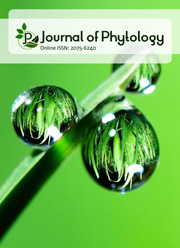Regeneration status of Albizia lebbeck Benth. in different Forest Types of Uttarakhand, Northern India
DOI:
https://doi.org/10.25081/cb.2025.v16.9490Keywords:
Regeneration, Environmental conditions, Seedlings, SamplingsAbstract
The ability of a species to survive in the community under a range of environmental circumstances depends on its regeneration. This study evaluates the regeneration status of Albizia lebbeck across Uttarakhand’s various forest types. The species was found in five different forest types and the overall regeneration was determined to be ‘Good’. The highest seedling density (900 ha-1) was recorded for West Gangetic Moist Mixed Deciduous Forest, while the lowest (100 ha-1) was observed in the Upper or Himalayan Chir Pine Forest. The highest adult density (70 ha-1) was found in Ban Oak Forest and West Gangetic Moist Mixed Deciduous Forest and the least (20 ha-1) was found in Northern Dry Mixed Deciduous Forest. There was a complete absence of sapling stages in the Northern Dry Mixed Deciduous Forest (5B/C2) and Upper or Himalayan Chir Pine Forest (9/C1b) which indicates disturbances in these regions.
Downloads
References
Ballabha, R., Tiwari, J. K., & Tiwari, P. (2013). Regeneration of tree species in the sub-tropical forest of Alaknanda Valley, Garhwal Himalaya, India. Forest Science and Practice, 15, 89-97. https://doi.org/10.1007/s11632-013-0205-y
Barik, S. K., Rao, P., Tripathi, R. S., & Pandey, H. N. (1996). Tree Dynamics of tree seedling population in a humid subtropical forest of northeast India as related to disturbances. Canadian Journal of Forest Research, 26(4), 584-589. https://doi.org/10.1139/x26-067
Champion, S. H. G., & Seth, S. K. (1968). A revised survey of the forest types of India. New Delhi, India: Government of India Publications.
Dutta, G., & Devi, A. (2013). Plant diversity, population structure, and regeneration status in disturbed tropical forests in Assam, northeast India. Journal of Forestry Research, 24, 715-720. https://doi.org/10.1007/s11676-013-0409-y
Good, N. F., & Good, R. E. (1972). Population dynamics of tree seedlings and saplings in mature Eastern hardwood forest. Bulletin of Torrey Botanical Club, 99(4), 172-178. https://doi.org/10.2307/2484571
Halle, F., Oldemann, R. A., & Tomlinson, P. B. (1978). Tropical Tree and Forests: An Architectural Analysis. Berlin, Heidelberg: Springer.
Iqbal, K., Pala, N. A., Bhat, J. A., & Negi, A. K. (2012). Regeneration status of trees around Khoh river in Garhwal Himalaya. Indian Journal of Forestry, 35(4), 471-476. https://doi.org/10.54207/bsmps1000-2012-N01N7O
Jones, R. H., Sharitz, R. R., Dixon, P. M., Segal, D. S., & Schneider R. L. (1994). Woody plant regeneration in four floodplain forests. Ecological Monographs, 64(3), 345-367. https://doi.org/10.2307/2937166
Kadavul, K., & Parthasarathy, N. (1999). Plant biodiversity and conservation of tropical semi-evergreen forests in the Shervarayan hills of Eastern Ghats, India. Biodiversity & Conservation, 8, 421-439. https://doi.org/10.1023/A:1008899824399
Kershaw, K. A. (1973). Quantitative and Dynamic Plant Ecology. (2nd ed.). London, UK: ELBSD & Edward Arnold.
Khan, M. L., & Tripathi, R. S. (1989). Effects of stump diameter, stump height and sprout density on the sprout growth of four tree species in burnt and unburnt forest plots. Acta Oecologica, 10(4), 303-316.
Khan, M. L., Rai, J. P. N., & Tripathi, R. S. (1987). Population structure of some tree species in disturbed and protected subtropical forests of north-east India. Acta Ecologica, 8(3), 247-255.
Khumbongmayum, A. D., Khan, M. L., & Tripathi, R. S. (2005). Survival and growth of seedlings of a few tree species in the four sacred groves of Manipur, Northeast India. Current Science, 88, 1781-1788.
Khumbongmayum, A. D., Khan, M. L., & Tripathi, R. S. (2006). Biodiversity conservation in sacred groves of Manipur, Northeast India: population structure and regeneration status of woody species. Biodiversity and Conservation, 15, 2439-2456. https://doi.org/10.1007/s10531-004-6901-0
Malik, A. Z., & Bhatt, A. B. (2016). Regeneration status of tree species and survival of their seedlings in Kedarnath wildlife sanctuary and its adjoining areas in Western Himalaya, India. Tropical Ecology, 57, 677-690.
Mishra, B. P., Tripathi, O. P. & Laloo, R. C. (2005). Community characteristics of a climax subtropical humid forest of Meghalaya and population structure of ten important tree species. Tropical Ecology, 46, 241-251.
Mishra, R. (1968). Ecology Workbook. Calcutta, India: Oxford & IBH.
Pala, N. A., Negi, A. K., Gokhle, Y., & Todaria, N. P. (2013). Tree regeneration status of sacred and protected landscapes in Garhwal Himalaya, India. Journal of Sustainable Forestry, 32(3), 230-246. https://doi.org/10.1080/10549811.2013.762492
Pokhriyal, P., Uniyal, P., Chauhan, D. S., & Todaria, N. P. (2010). Regeneration status of tree species in forest of Phakot and Pathri Rao watersheds in Garhwal Himalaya. Current Science, 98(2), 171-175.
Pritts, M. P., & Hancock, J. F. (1983). The effect of population structure on growth patterns in the woody goldenrod Solidago pauciflosculosa. Canadian Journal of Botany, 61(7), 1955-1958. https://doi.org/10.1139/b83-210
Rajkumar, M., & Parthasarathy, N. (2008). Tree diversity and structure of Andaman Giant Evergreen Forests, India. Taiwania, 53(4), 356-368.
Rasingam, L., & Parathasarathy, N. (2009). Tree species diversity and population structure across major forest formations and disturbance categories in Little Andaman Island, India. Tropical Ecology, 50(1), 89-102.
Sahu, S. C., Dhal, N. K., & Mohanty, R. C. (2012). Tree species diversity, distribution and population structure in a tropical dry deciduous forest of Malyagiri hill ranges, Eastern Ghats, India. Tropical Ecology, 53(3), 163-168.
Sarkar, M., & Devi A. (2014). Assessment of diversity, population structure and regeneration status of tree species in Hollonggapar Gibbon Wildlife Santuary, Assam, Northeast India. Tropical Plant Research, 1(2), 26-36.
Saxena, A. K., & Singh, J. S. (1982). A phytosociological analysis of woody species in forest communities of a part of Kumaun Himalaya, India. Vegetatio, 50, 3-22. https://doi.org/10.1007/BF00120674
Saxena, A. K., & Singh, J. S. (1984). Tree population structure of certain Himalayan forest associations and implications concerning their future composition. Vegetatio, 58, 61-69. https://doi.org/10.1007/BF00044928
Shankar, U. (2001). A case of high tree diversity in a Sal (Shorea robusta)-dominated lowland forest of Eastern Himalaya: Floristic composition, regeneration and conservation. Current Science, 81(7), 776-786.
Singh, S., Malik, Z. A., & Sharma, C. M. (2016). Tree species richness, diversity and regeneration status in different Oak (Quercus spp.) dominated forests of Garhwal Himalaya, India. Journal of Asia-Pacific Biodiversity, 9(3), 293-300. https://doi.org/10.1016/j.japb.2016.06.002
Singhal, R. M., & Soni, S. (1989). Quantitative ecological analysis of some woody species of Mussoorie Himalayas (UP). Indian Forster, 115(5), 327-337.
Sukumar, R., Suresh, H. S., Dattaraja, H. S., & Joshi, N. V. (1998). Dynamics of a tropical deciduous forest: Population changes (1988 through 1993) in a 50-hectare plot at Mudumalai, southern India. In: F. Dallmeier and J. A. Comiskey (Eds.) Forest Biodiversity Research, Monitoring and Modeling: Conceptual Background and Old World Case Studies (Vol. 1, pp. 529-540) Chennai, India: CBS Publishers and Distributors Pvt Ltd.
Tynsong, H., & Tiwari, B. K. (2011). Diversity and population characteristics of woody species in natural forests and arecanut agroforests of south Meghalaya, Northeast India. Tropical Ecology, 52, 243-252.
Upadhaya, K., Pandey, H. N., Law, P. S., & Tripathi, R. S. (2004). Diversity and population characteristics of woody species in subtropical humid forest exposed to cultural disturbances in Meghalaya, Northeast India. Tropical Ecology, 45(2), 303-314.
Welden, C. W., Hewett, S. W., Hubbell, S. P., & Foster, R. B. (1991). Sapling survival, growth and recruitment: relationship to canopy height in a neotropical forest. Ecology, 72(1), 35-50. https://doi.org/10.2307/1938900
Whittaker, R. H. (1972). Evolution and measurement of species diversity. Taxon, 21, 213-51. https://doi.org/10.2307/1218190
Zasada, J. C., Foote, M. J., Deneke, F. J., & Parkerson, R. H. (1978). Case history of an excellent white spruce cone and seed crop in interior Alaska: cone and seed production, germination, and seedling survival. Alaska, US: Pacific Northwest Forest and Range Experiment Station.
Published
How to Cite
Issue
Section
Copyright (c) 2025 Anup Chandra, P. K. Verma, S. Prajapati, S. Baig, H. B. Naithani

This work is licensed under a Creative Commons Attribution-NonCommercial 3.0 Unported License.



 .
.